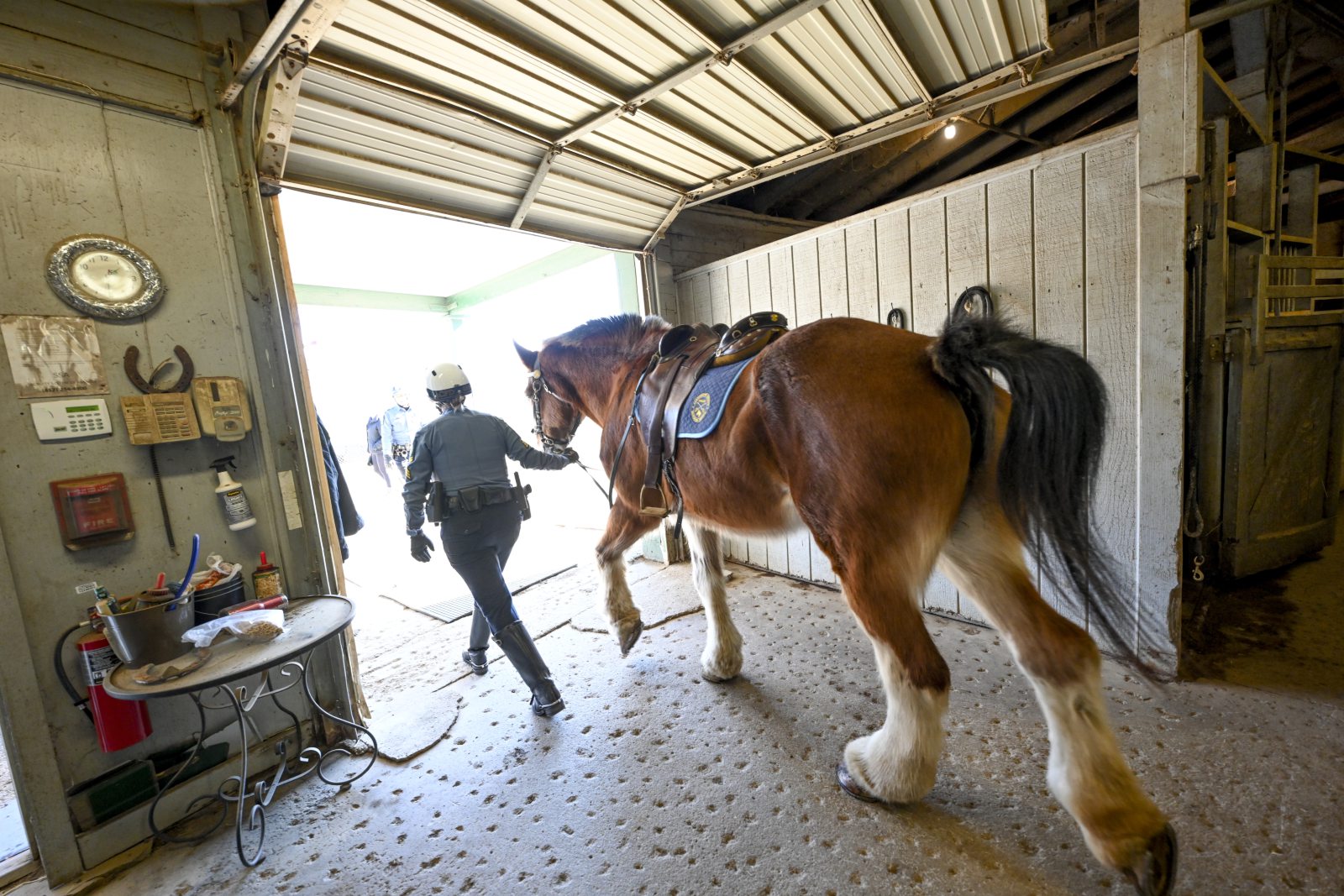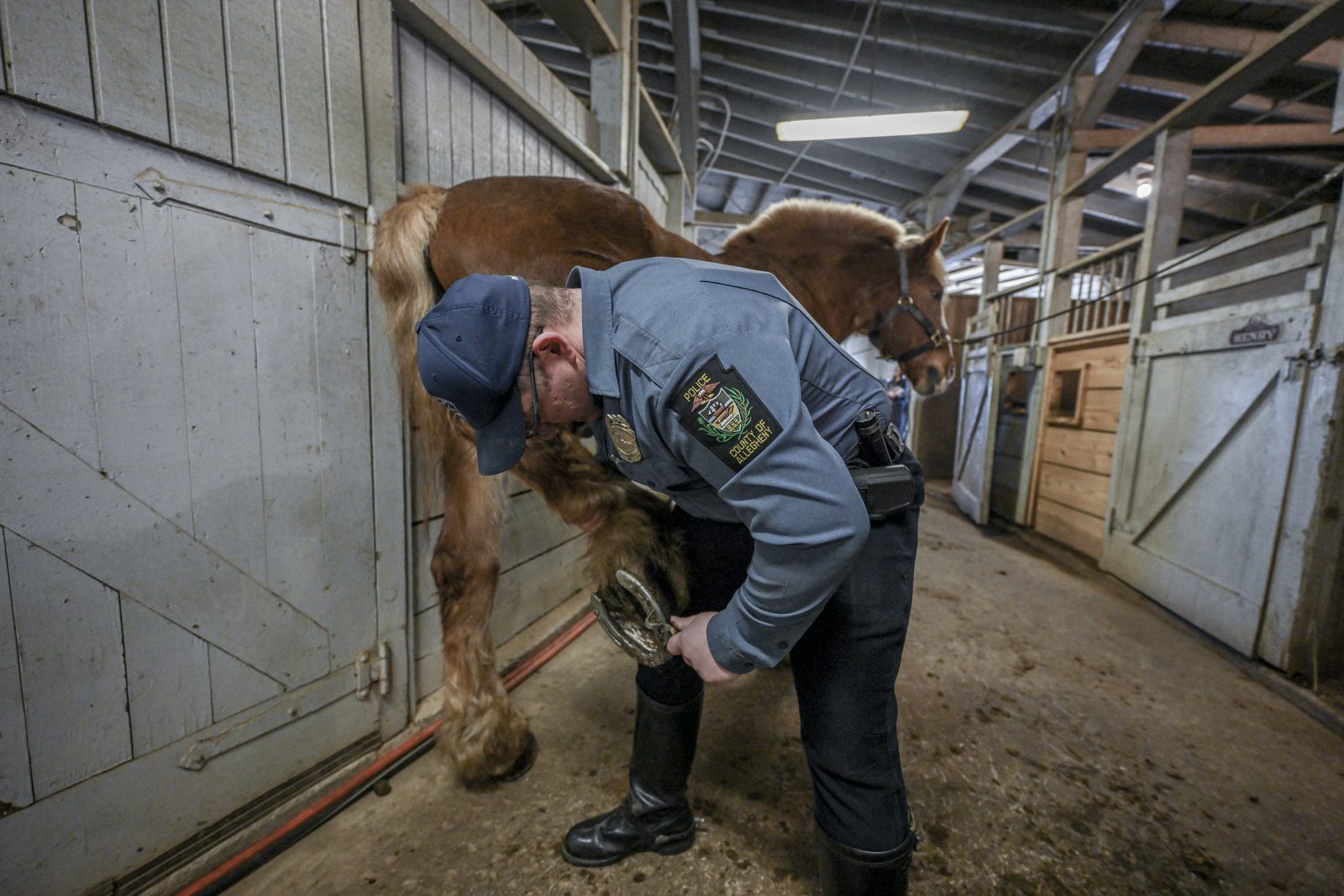

Story by JOANNE KLIMOVICH HARROP
Photos by LOUIS B. RUEDIGER
Tribune-Review
May 26, 2024
On Monday, the Allegheny County Mounted Police Unit will add a touch of tradition and spectacle to the South Hills Memorial Day Parade.
While officers on horseback are a rarer sight compared to those in cars or on motorcycles, “They definitely create a presence,” said Sgt. Jason Donaldson of the Allegheny County Police Department’s Mounted Patrol Unit.
Starting at 10 a.m. on Brookline Boulevard and ending with a service at Mt. Lebanon Cemetery, the unit’s presence in the parade highlights the unique role and historical significance of mounted patrols in modern law enforcement, showcasing their versatility from crowd control to community engagement.
In 2023, Allegheny County horses were dispatched to about 50 details. Pittsburgh’s annual St. Patrick’s Day parade is the unofficial start of when the county horses begin making appearances each year, Donaldson said as he stood outside the stable in South Park.
In addition to parades and eclipse viewings, the horses are invited to community happenings and often serve at concerts, sporting events, protests, demonstrations and political rallies.

In the past year, the Pittsburgh Bureau of Police brought horses to events including National Night Out, Take Our Kids to Work Day, Bloomfield Halloween Parade, Light Up Night, First Night, Columbus Day Parade, St. Patrick’s Day, and the July 4 celebration, in addition to numerous school visits.
The size of the formation is situation-dependent based on the task, size of the crowd and topography, Donaldson said.
One horse can do the work of several officers when moving large groups of people. They are also used for patrol as they can access almost any terrain including places that police vehicles cannot navigate like sidewalks, alleys, hills and wooded areas.
They provide a height advantage to the officer when out patrolling where much more can be seen. The unit allows law enforcement to utilize the horses for special functions like crowd control and search and rescue, giving officers a vantage point over the crowd and terrain that would otherwise not be available, according to Lt. Adam Reed, head of the communications office for the state police in Harrisburg.
However, because of their expense and fairly narrow purpose, they are far less common than other types of specialized units like bicycle or motorcycle units.
Reed said they are primarily used for crowd control, ceremonial and community events, and in more rural areas, search and rescue.
Mounted patrol units have been around for decades, Allegheny County Police Department’s unit was established in 1932 by a group of officers who served with the U.S. Calvary in World War I. Back then, the unit consisted of 48 horses — there were more horses than human officers.

Training for this work begins at the Pennsylvania State Police Academy in Hershey. All state troopers learn basic horse care, grooming, tacking, mounting, riding, equitation — the art and practice of horsemanship and horse riding — formations, patrol and arrest techniques.
Various trainings are held throughout the year to keep troopers’ skills sharp, according to Reed. To this day, every state police cadet spends time in the stable in Hershey, where 24 horses that serve the entire state live.
“They have the drive to do this work,” Reed said. “There is a vetting process to train them not to be rattled by loud noises or fireworks and how to handle being around large crowds.”
Allegheny County has nine horses housed at the Allegheny County Police Stables in South Park. The city of Pittsburgh has six horses at a stable on the North Side near Riverview Park.
Currently, more than 150 mounted units are located in 40 states and Washington, D.C. This does not include patrols that are part of the National Park police or border patrol, according to Equine Land Conservation Resource.
Unlike race horses, they are not bred specifically for police work, Reed said.

Detective Walter Jones, an officer of the Pittsburgh police’s Mounted Patrol Unit, said he has gotten to know the horses’ personalities over the years.
“We know which one to take on which outing,” Jones said. “We know their disposition.”
Horses get people talking, often prompting folks to ask questions about this style of police work. Jones said they’ve taken horses to law enforcement job fairs as an incentive to get people into this line of work.
“We know how to keep the horses calm and happy,” Jones said. “We comfort them, and they trust us on their backs to keep them out of harm’s way. They form a bond with the rider and are willing to go out and work. Like any working partnership, it’s about give and take.”
While the Mounted Unit horses can be employed for specialized duties such as public disturbances, the Pittsburgh Bureau of Police find the animals to be most beneficial in the community space, Jones said. They can help quell unrest by their mere presence, but they also act as a gateway for individuals to positively interact with law enforcement officers.
Very few of the county officers have equine training, Donaldson said. He compared the horses and riders to a SWAT team with their deliberate movement.
The horses go out in most weather, though icy conditions can present challenges, Jones said. They haven’t had any major injury to a horse during his tenure. One got jabbed with a stop sign during a 2020 Pittsburgh protest following the death of George Floyd, but it didn’t cause a deep wound.
In Pittsburgh, the chief of police is responsible for the entire department. Daily patrolled deployment is handled by the Mounted Unit supervisor, and commander Wanda Duncan makes specialized deployment decisions in response to events in the city.
The average weight of the city’s police horses is between 1,300-1,800 pounds. As big as they are, Jones said horses naturally have a calming demeanor and presence.
“Anecdotally, there are studies that show that being near a horse can reduce one’s heart rate, reduce blood pressure, reduce the amount of cortisol (stress hormones), and cause an increase in endorphins,” Jones said. “We see the result of this calming effect not only when the animals are working around large crowds, but also when they are on display at public events.”
Research by the University of New England explored the therapeutic benefit of horses and found that equine-assisted psychotherapy has a calming effect on people. Horses are valued as therapy animals and used for therapeutic horseback riding to improve the posture of people with disabilities, the study said.
One of the great things about the horses is they bridge the gap between the community and the police, said Sgt. Carrie Neidigh, section supervisor for the state police Tactical Mounted Section, part of the Bureau of Emergency and Special Operations.
“People want to come up and talk to us, which they will be more likely to do than if we were in a patrol car,” Neidigh said. “When you do anything in formation like that, you draw attention. I am 5-foot-3 and I don’t get noticed, but when I am on a horse, people notice.”
At one time it was a requirement for all city and county police officers to learn how to care for and ride horses. Officers for the county’s mounted unit are now appointed by the superintendent, who holds interviews and a basic skills assessment of interested candidates and then makes the decision.
The only officers caring for the horses, past and present, are the ones in the mounted unit, Jones said. It’s a natural part of the job, and none of the officers mind doing so, as it’s a task that was expected upon joining the unit, Jones said.
In addition to the initial training at the academy in Hershey, individual units work monthly on formations and patrol techniques and ensure the horses are desensitized to noises, smells, obstacles and the environment.
They select new riders when the need arises.
“Like any other position, vacancies can arise due to retirements, transfers or promotions,” Reed said.

Most of the horses are donated. In 2018, the Pennsylvania State Police asked for donations of horses. They wanted geldings (castrated male horses) between the ages of 5 and 15 years old. The horse must stand at least 5-foot-4 inches at the shoulder.
Drafts and draft crossbreeds are preferred. The county has draft horse breeds, including Percherons, Belgians, a Clydesdale, a Gypsy Vanner and an Appendix draft-cross.
According to Donaldson, draft horses are large breeds bred to do laborious tasks like farming and pulling implements or carriages.
“Because they are larger and stronger, they have the endurance to work for long periods of time,” Donaldson said. “They are also more docile, which makes them more predictable when working in an urban environment. The draft breeds are also preferred because their larger size makes them more intimidating when it comes to managing large crowds of people.”
Upon retirement, state police horses are offered back to their original owners, Reed said. The department finds them suitable homes if the original owners are unwilling or unable to accept the animals, Reed said.
In general, the horses can work into their early 20s barring any health issues.
According to Pittsburgh’s Department of Public Safety and Allegheny County, the cost of a horse varies based on its training, but the most expensive horse was valued at $10,000 when donated. The state also said the cost is in the $10,000 range.
The average cost of caring for a horse for the year is around $11,000 for expenses such as food and veterinary care, shavings for stall floors, horseshoes, transportation costs, board, etc., Jones said.
The budget for the horses varies year to year depending on the size of the unit, Reed said. This year the county has budgeted approximately $38,000 for feed, hay and additional barn supplies and accessories.

Every rider has a favorite horse but cross-trains on all of the horses, Donaldson said. His favorite is Jimbo, a 10-year-old Percheron Gelding and one of the largest horses the county has had.
Their expense not only involves the housing, food, and medical care for the horses, but also it involves the staffing of officers who are assigned to the unit. Training is critical because both horse and rider must be extremely proficient, Hegarty said.
“In the last decade as shortages in police staffing increased, specialized units, including mounted units, have often been disbanded in order for agencies to meet community demands for more basic services,” Hegarty said. “Overall, I think mounted units can be a very effective tool for law enforcement agencies in the right situations, but because of their fairly narrow use, they represent a luxury for most agencies rather than a necessity.”
From parades to protests, these horses are not just tools, but partners who embody the spirit of service.

JoAnne Klimovich Harrop is a Tribune-Review staff writer. You can contact JoAnne at jharrop@triblive.com or via Twitter @joannescoop.
Louis B. Ruediger is a Tribune-Review photographer. You can contact Louis via email at lruediger@triblive.com.